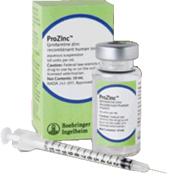Efficacy of Protamine Zinc Recombinant Human Insulin for Controlling Hyperglycemia in Dogs with Diabetes Mellitus
Journal of Veterinary Internal Medicine Volume 26 (Issue 1), pp. 109-115, January/February 2012.
Background
Treatment of diabetes mellitus in dogs requires daily insulin administration to achieve control of hyperglycemia. Commonly used insulin preparations for diabetes in dogs include recombinant human NPH insulin and purified pork source lente insulin (Vetsulin in the USA; Caninsulin elsewhere in the world) (1,2). However, the withdrawal of purified pork source lente insulin by the FDA in November 2009 has practicing veterinarians in the USA searching for an alternative insulin replacement. Recombinant human NPH insulin can be used to treat diabetes in dogs, but control of diabetes is difficult in some dogs because of NPH's short duration of action (1). Alternative insulin preparations are needed when NPH insulin is ineffective in diabetic dogs.
A recombinant human PZI preparation (rhPZI, Prozinc, Boehringer Ingelheim Vetmedica) was approved by the FDA in 2009 for managing diabetes in cats (3,4). This recent availability of this insulin may provide another viable insulin option for treating diabetic dogs. This study evaluated the efficacy of recombinant human protamine zinc insulin (ProZinc) in dogs with diabetes mellitus (5).
Hypothesis
Protamine zinc insulin (rhPZI; ProZinc) is effective for treating diabetic dogs.
Animals
Seventeen dogs (6 newly diagnosed and 11 insulin-treated diabetics) were included in this study.
Methods
Prospective clinical trial. Dogs were treated with rhPZI for 60 days. Control of glycemia was assessed on days 7, 14, 30, and 60 by evaluation of history, physical examination, body weight, serum fructosamine concentration, and blood glucose concentrations measured before and 2, 4, 6, 8, and 10 hours after rhPZI administration. Adjustments in dosage of rhPZI were made as needed to control glycemia.
Results
Compared to pretreatment (day 1) results, protamine zinc insulin (rhPZI) administration resulted in significant decreases in both 10-hour mean blood glucose (from 457 to 299 mg/dl) and mean serum fructosamine concentrations (557 to 478 mg/dl) at day 60.
By day 60, polyuria and polydipsia had improved in 14 of the 17 dogs, body weight was stable or increased in 16 of 17, 10-hour mean blood glucose concentrations had decreased in 16 of 17, and serum fructosamine concentration had decreased in 11 of 17 dogs, compared with day 1. Hypoglycemia (<80 mg/dl) was the only consistent adverse event.
Conclusions
PZI (ProZinc insulin) is effective in diabetic dogs and can be considered as an alternative treatment in diabetic dogs that are poorly-controlled using other insulin preparations.
My Bottom Line:
PZI insulin (Prozinc, Boehringer Ingelheim Vetmedica) was effective in improving or maintaining control of the diabetic state in almost all of the diabetic dogs in this study.
However, the median PZI insulin dosage required for glycemic control in these diabetic dogs was much higher than reported for other insulin preparations in dogs with diabetes. The final median PZI dosage needed in these dogs was 0.9 U/kg, bid (range, 0.4–1.5 U/kg/injection). These doses are much higher than that generally needed when dogs are treated with either NPH or Vetsulin/Caninsulin, where insulin dosages ranging from 0.25 to 1.0 U/kg, bid (median, 0.5 U/kg/injection) are generally effective in regulation of the diabetic state (1,2).
The higher PZI dosage requirements in the dogs of this study is likely due to the fact that PZI is a long-acting insulin. Compared with intermediate-acting insulins such as NPH or lente, longer-acting insulin preparations typically have a slower rate of absorption and lower peak blood insulin concentration (6). These properties may result in higher PZI dosage requirements to attain comparable glycemic control as compared to the shorter-acting insulin prepartions.
Based on the results of this study, use of ProZinc at a starting dose of 0.5 U/kg, bid, should be considered in diabetic dogs that are poorly controlled because of the short duration of NPH or Vetsulin/Caninsulin. Prolonged duration of PZI, however, may result in problems with hypoglycemia and induction of the Somogyi response when PZI is administered twice a day in a few diabetic dogs.
The biggest disadvantage of ProZinc for use in dogs is the relatively high cost of injecting the higher doses of insulin needed. This is especially true in larger breed dogs with doses of 30-50 U, bid, might be needed to achieve diabetic control.
References:
- Palm CA, Boston RC, Refsal KR, et al. An investigation of the action of neutral protamine Hagedorn human analogue insulin in dogs with naturally occurring diabetes mellitus. Journal of Veterinary Internal Medicine 2009;23:50–55.
- Fleeman LM, Rand JS, Morton JM. Pharmacokinetics and pharmacodynamics of porcine insulin zinc suspension in eight diabetic dogs. Veterinary Record 2009;164:232–237.
- Nelson RW, Henley K, Cole C, et al. Field safety and efficacy of protamine zinc recombinant human insulin for treatment of diabetes mellitus in cats. J Vet Intern Med. 2009;23:787-93.
- Norsworthy G, Lynn R, Cole C. Preliminary study of protamine zinc recombinant insulin for the treatment of diabetes mellitus in cats. Veterinary Therapeutics 2009;10:24-28.
- Della Maggiore A, Nelson RW, Dennis J, et al. Efficacy of protamine zinc recombinant human insulin for controlling hyperglycemia in dogs with diabetes mellitus. Journal of Veterinary Internal Medicine 2012;26: 109-115.
- Wallace MS, Peterson ME, Nichols CE. Absorption kinetics of regular, isophane, and protamine zinc insulin in normal cats. Domestic Animal Endocrinology 1990;7:509-515.
Źródło: endocrinevet.blogspot.com










